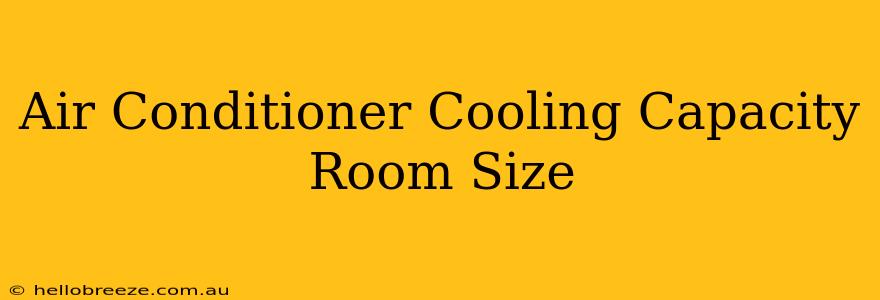Choosing the right air conditioner can be tricky. One of the most crucial factors is understanding the relationship between air conditioner cooling capacity and room size. Getting this wrong can lead to an inefficient, expensive, or even ineffective cooling system. This guide will help you determine the correct cooling capacity for your specific room, ensuring comfortable temperatures all summer long.
Understanding BTU Ratings
The cooling capacity of an air conditioner is measured in British Thermal Units (BTUs). One BTU represents the amount of heat required to raise the temperature of one pound of water by one degree Fahrenheit. A higher BTU rating indicates a more powerful air conditioner capable of cooling larger spaces.
BTU Needs Vary by Room Size and Factors
While there are general guidelines, the precise BTU requirements depend on several factors beyond just square footage:
- Room Size: Larger rooms naturally require more cooling power.
- Ceiling Height: Higher ceilings mean more volume to cool, demanding a higher BTU rating.
- Insulation: Well-insulated rooms retain coolness better, requiring less powerful AC units. Poor insulation means you'll need a more powerful unit.
- Number of Windows & Sunlight Exposure: South-facing rooms with large windows receive more direct sunlight and heat, needing more BTUs to compensate.
- Climate: Hotter climates obviously require more cooling power.
- Number of Occupants & Appliances: More people and heat-generating appliances (computers, TVs) increase the cooling load.
Calculating the Right BTU for Your Room
Several online calculators can estimate the required BTU based on the room's dimensions and factors mentioned above. However, using these as a starting point is crucial; they provide estimates and not precise figures. Consult a professional HVAC technician for precise calculations, especially for complex situations.
Approximate BTU Guidelines (Use with Caution):
These are rough estimates and may not be accurate for all situations. Always consider the additional factors mentioned above.
- Small Room (under 150 sq ft): 5,000-7,000 BTUs
- Medium Room (150-300 sq ft): 8,000-12,000 BTUs
- Large Room (over 300 sq ft): 12,000 BTUs and above
Important Note: Choosing an air conditioner with too few BTUs will lead to inadequate cooling, leaving your room hot and uncomfortable. Conversely, an air conditioner with too many BTUs will be unnecessarily expensive to run and might cycle on and off too frequently, potentially leading to shorter lifespan.
Beyond BTU: Other Important Considerations
While BTU is the primary factor, other aspects influence your choice:
- Energy Efficiency (SEER Rating): The Seasonal Energy Efficiency Ratio (SEER) indicates how efficiently the AC uses energy. Higher SEER ratings (13 or higher) mean lower electricity bills.
- Type of Air Conditioner: Consider portable, window, or split-system units based on your needs and installation possibilities.
- Features: Noise levels, smart features (Wi-Fi control), and dehumidification capabilities are important factors to consider.
Professional Installation is Key
Professional installation is highly recommended for all air conditioners, especially for window or split systems. This ensures optimal performance, safety, and proper installation within your home's electrical system. A professional can help you determine the most appropriate unit and install it correctly, saving you money and potential headaches in the long run.
Choosing the right air conditioner size is a crucial step in ensuring comfort and energy efficiency. By carefully considering the factors outlined above and consulting a professional when needed, you can find the perfect air conditioner to keep your home cool and comfortable.

